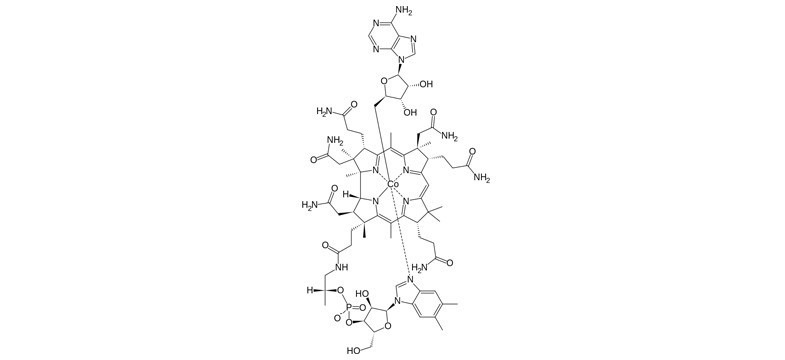Adenosylcobalamin: Natural, Bioactive Vitamin B12
Adenosylcobalamin is a natural form of vitamin B12, which alongside hydroxocobalamin is the form most frequently found in food (1). In our body as well, adenosylcobalamin is the most common vitamin B12 form in all of our organs and tissues, making up approximately 20% of the B12 found in the blood.
Adenosylcobalamin is one of the two bioactive coenzyme forms of vitamin B12 that our body really needs – the other of which is methylcobalamin. All other forms of the vitamin must first be converted into either of these bioactive coenzymes in order to be utilised.
For most people, this conversion process is simple and trouble-free. However, in the case of certain genetic disorders, nutrient deficiencies or metabolic problems this process can be disrupted.
Adenosylcobalamin
- One of the bioactive coenzyme forms of vitamin B12
- Most prevalent B12 form in the organs
- Form of B12 in the body’s store (liver)
- Takes effect in the cells
- Most common form in food (especially meat)
The Effects of Adenosylcobalamin B12
Adenosylcobalamin is the most prevalent form of B12 in our body’s cells. First and foremost, our largest store of the vitamin is found in the liver; adenosylcobalamin’s actual site of action however is in the mitochondria: the “powerhouses” of our cells.
Energy production
In the mitochondria, adenosylcobalamin is a chemical building block of the enzyme methylmalonyl-CoA mutase. This enzyme is responsible for the transformation of methylmalonyl-CoA to succinyl-CoA, which in turn is part of the citrate cycle. The citrate cycle is a central metabolic process, which generates adenosine triphosphate (ATP) – the universal energy provider in the human body (2, 3). A deficiency of adenosylcobalamin hence leads to the impairment of ATP production and, as a result, to chronic fatigue and exhaustion, muscle weakness, weight loss and developmental disorders.
Further reading: Vitamin B12 and Energy
Nerves
In the reaction described above, the harmful methylmalonic acid is also reduced, which among other things has a strong nerve-damaging effect as it impairs the synthesis of fatty acids. This is because fatty acids are needed for the constant renewal of the myelin sheath: the special protective layer over nerve cells.
An adenosylcobalamin shortage thus damages the myelin sheath, causing nerve degeneration and the death of neurons.
More information: Vitamin B12 and Nerves
Hormones and amino acids
In addition to these effects, adenosylcobalamin plays a role in the metabolism of important amino acids and hormones, for example: valine, isoleucine, threonine, methionine, thymine and cholesterol.
Applications of Adenosylcobalamin
For many year, adenosylcobalamin has been successfully administered by many doctors and naturopaths. According to its spectrum of action, the central areas of application are as follows:
- Chronic fatigue and exhaustion
- Muscle weakness
- Weight loss and anorexia (4)
- Fibromyalgia
- Liver damage
- Hepatitis (4)
- Neuropathies/nerve damage, nervous system diseases
A Therapeutic Agent for Multiple Severe Diseases
As per the experience of many therapist, the administration of adenosylcobalamin can be an interesting therapeutic option for the aforementioned symptoms and many further severe diseases. For those suffering from one of the symptoms specified above, it can be very useful to consult a therapist experienced in micro nutrient medicine on the possible application of adenosylcobalamin.
Further reading: Vitamin B12 as Medicine
Adenosylcobalamin: Vital but Harder to Find
Despite the important and broad effects of adenosylcobalamin, it is surprisingly rare to find in vitamin B12 supplements. The reason for this is that it legal status was unclear for years. Today, however, adenosylcobalamin has been approved as an active ingredient in the EU.
Adenosylcobalamin is the most frequently-found form of B12 in all tissues and organs and also one of the most common in foods. It is used by the body in the same way as methylcobalamin, which is why supplements ideally contain both.
Furthermore, pure methylcobalamin supplements are being increasingly brought into question, since they can lead to over-methylation and also only provide one of the two necessary B12 forms. The ideal solution is therefore a mixture of methylcobalamin, adenosylcobalamin and hydroxocobalamin.
Sources:
- Farquharson J, Adams JF. The forms of vitamin B12 in foods. Br J Nutr. 1976 Jul;36(1):127-36. PubMed PMID: 820366.
- Marsh EN. Coenzyme B12 (cobalamin)-dependent enzymes. Essays Biochem. 1999;34:139-54. Review. PubMed PMID: 10730193.
- Wood, H. G., Kellermeyer, R. W., Stjernholm, R. and Allen, S. H. G. (1964), METABOLISM OF METHYLMALONYL-CoA AND THE ROLE OF BIOTIN AND B12 COENZYMES. Annals of the New York Academy of Sciences, 112: 661–679. doi: 10.1111/j.1749-6632.1964.tb45043.x
- Korkina MB, Korchak GM, Medvedev DI Clinico-experimental substantiation of the use of carnitine and cobalamin in the treatment of anorexia nervosa Zhurnal Nevropatologii i Psikhiatrii Imeni S.S. Korsakova (Moscow, Russia : 1952) [1989, 89(2):82-87] (PMID:2728726)
- Iwarson S, Lindberg J Coenzyme-B12 therapy in acute viral hepatitis. Scandinavian Journal of Infectious Diseases [1977, 9(2):157-158](PMID:897571)


